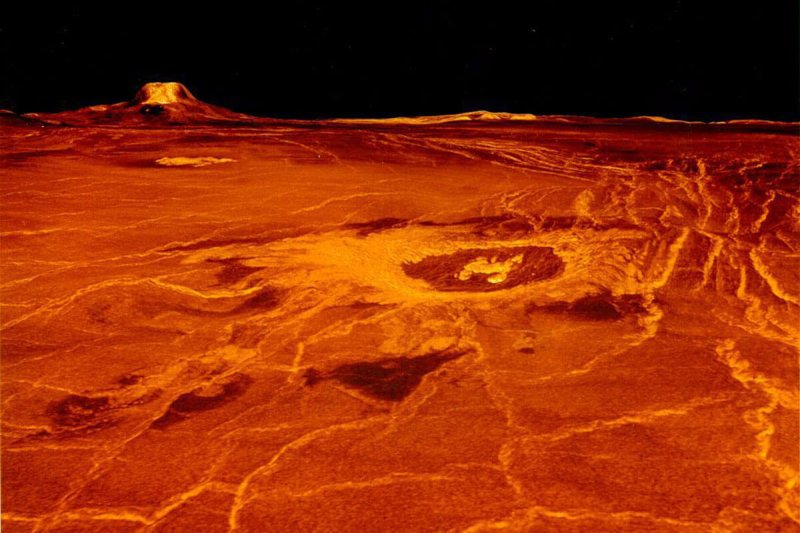From planet of love to scorching Hell planet—the image of Venus has changed considerably since ancient times, because it is no longer just the third brightest natural object in Earth’s skies. The ancients equated the mysterious third light with the goddess of love; in Greece that was Aphrodite, whom the Romans conflated with the goddess Venus. That’s where our closest planetary neighbor got its name and why Men are from Mars, Women are from Venus worked as a best-selling title, as recently as 1992, and still sells. But since the mid-20th century, we’ve known in detail why a paradise Venus is not. Average temperature on the surface is a scorching 462° Celsius (864° Fahrenheit) while atmospheric pressure is 90 times that of Earth at sea level, or equivalent to being at 900 meters depth in Earth’s oceans.
A handful of Russian landing probes have survived for several minutes on the planet’s surface before being cooked and crushed, but the conditions are unquestionably inhospitable for life forms. Consequently, you do not hear about astrobiologists searching for native microorganisms on the Venusian surface the way you hear about the search for microorganisms on Mars. Nevertheless, since the late 20th century, planetary scientists have speculated that Venus could have boasted a much more hospitable environment in the distant past, perhaps 2-3 billion years ago. That’s around the time that Earth was accumulate oxygen in its oceans and atmosphere. At that point in history, Venus and Earth may have had similar climates.
What’s been in the news lately is a study involving computer climate simulations in which data from NASA’s Magellan mission to Venus were found to support the idea of a once habitable Venus. The study involved researchers from NASA, Uppsala University in Sweden, Columbia University, and the Planetary Science Institute in Tucson, AZ.
Climate studies of all inner Solar System planets are connected
Much to the chagrin of climate science deniers who accuse NASA’s focus on studying the Earth’s climate from space as part of a conspiracy, the data and insights that planetary scientists can get from studying one planet have implications for understanding the past, present, and future of other planets.
As Carl Sagan explained in his 1980 PBS science TV program Cosmos, Earth, Venus, and Mars all orbit within a range of distance from the Sun that make liquid water possible. Today, astrobiologists call this the Goldilocks zone. While you’d expect Venus to be a little warmer on average than Earth, and Mars a little cooler, the enormous climate differences that we see today on these three planets have more to do with the atmospheres of the planets. Venus has enormous quantities of greenhouse gasses, particularly carbon dioxide (CO2) in its air and Sagan thought the planet may have gone through a runaway, in which release of CO2 from rock increased the planetary greenhouse effect, increasing temperature and when it reached a certain threshold this release more CO2 from rock. That, in turn triggered a viscous cycle, eventually producing enough greenhouse effect for the temperatures that we see on Venus today. Sagan also talked about the opposite climate shift happening int he past on Mars, making the latter planet much colder and helping it to lose its surface water.
What’s happening today is the accumulation of data from spacecraft looking at all three planets. This is entirely appropriate to the NASA job description, regardless of its implications. But while climate science deniers may shrug off such studies, they are of interest to those interested in survival of humanity not just on Earth, but on future colonies that may not be limited to Mars.
Could we make Venus into another Earth?
With futurists like Elon Musk proposing Mars colonization, the idea that we might terraform Mars—change its atmosphere and other aspects of its environment so that it’s more like Earth—is a real part of the discussion. The argument for terraforming Mars is that if it was once more like Earth (wetter, warmer, thicker atmosphere) then we should be able to change it back. But if Venus too was more Earth-like, terraforming might be considered there too. In fact, having gravity almost matching that of Earth and being closer to the Sun, making solar energy easier than on Mars, a terraformed Venus might be a better prospect for humanity than a terraformed Mars.
Opposite the strategy for Mars, terraforming Venus would involve shutting off the greenhouse effect. This is something that one of the researchers on the new Venus climate study mentioned earlier, David Grinspoon, says could be possible.
“It’s the same problem people are considering with geoengineering Earth by diminishing solar radiation, either by clouds of aerosols in the atmosphere or some kind of sunshade in orbit,” said Grinspoon, who is Senior Scientist at the Planetary Science Institute and adjunct professor of astrophysical and planetary sciences at University of Colorado, Boulder.
I don’t advocate this for Earth,” Grinspoon noted to me. “But in some distant future we might want to try it on Venus, where there is presumably no biosphere that we’d be putting at risk and potential to create a new biosphere. If you collapse the greenhouse beyond a certain point it could become self-reinforcing, with CO2 being taken up in carbonate rocks.”
But this does not mean that Venus is the perfect candidate for terraformation. Importantly, Venus lacks water, so to terraform our sister planet, we’d need a fix.
“We might have to crash a lot of comets into [the planet],” Grinspoon said. “There is, after all, a lot of water locked away in icy bodies in the outer solar system. If we wanted to get clever we could use the same comet impacts to re-water Venus and kick up impact-generated dust that would collapse the greenhouse. Don’t try this at home, kids!”
David Warmflash is an astrobiologist, physician and science writer. Follow @CosmicEvolution to read what he is saying on Twitter.































